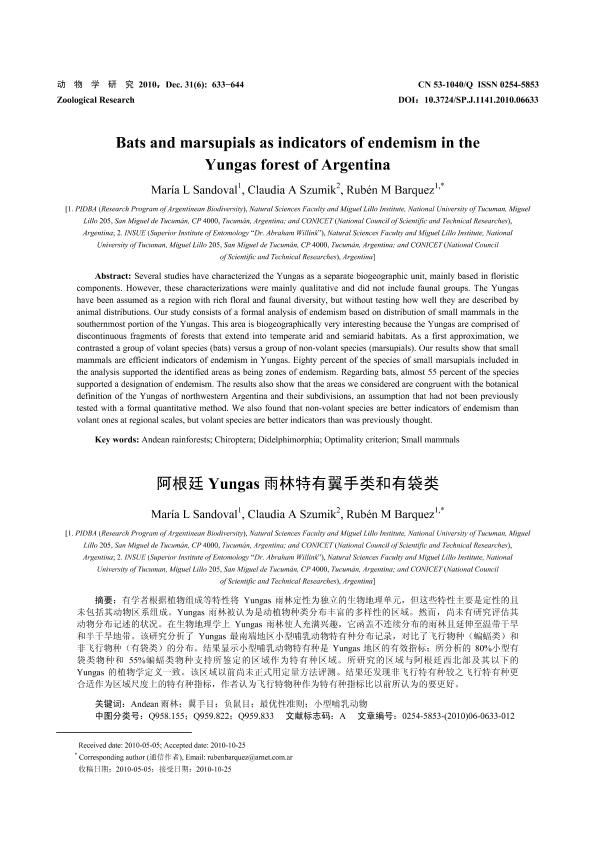Mostrar el registro sencillo del ítem
dc.contributor.author
Sandoval Salinas, Maria Leonor

dc.contributor.author
Szumik, Claudia Adriana

dc.contributor.author
Barquez, Ruben Marcos

dc.date.available
2019-03-25T17:39:47Z
dc.date.issued
2010-12
dc.identifier.citation
Sandoval Salinas, Maria Leonor; Szumik, Claudia Adriana; Barquez, Ruben Marcos; Bats and marsupials as indicators of endemism in the Yungas forest of Argentina; Bioline International; Zoological Research; 31; 6; 12-2010; 633-644
dc.identifier.issn
0254-5853
dc.identifier.uri
http://hdl.handle.net/11336/72430
dc.description.abstract
Several studies have characterized the Yungas as a separate biogeographic unit, mainly based in floristic components. However, these characterizations were mainly qualitative and did not include faunal groups. The Yungas have been assumed as a region with rich floral and faunal diversity, but without testing how well they are described by animal distributions. Our study consists of a formal analysis of endemism based on distribution of small mammals in the southernmost portion of the Yungas. This area is biogeographically very interesting because the Yungas are comprised of discontinuous fragments of forests that extend into temperate arid and semiarid habitats. As a first approximation, we contrasted a group of volant species (bats) versus a group of non-volant species (marsupials). Our results show that small mammals are efficient indicators of endemism in Yungas. Eighty percent of the species of small marsupials included in the analysis supported the identified areas as being zones of endemism. Regarding bats, almost 55 percent of the species supported a designation of endemism. The results also show that the areas we considered are congruent with the botanical definition of the Yungas of northwestern Argentina and their subdivisions, an assumption that had not been previously tested with a formal quantitative method. We also found that nonvolant species are better indicators of endemism than volant ones at regional scales, but volant species are better indicators than was previously thought.
dc.description.abstract
摘要:有学者根据植物组成等特性将 Yungas 雨林定性为独立的生物地理单元,但这些特性主要是定性的且 未包括其动物区系组成。Yungas 雨林被认为是动植物种类分布丰富的多样性的区域。然而,尚未有研究评估其 动物分布记述的状况。在生物地理学上 Yungas 雨林使人充满兴趣,它函盖不连续分布的雨林且延伸至温带干旱 和半干旱地带。该研究分析了 Yungas 最南端地区小型哺乳动物特有种分布记录,对比了飞行物种(蝙蝠类)和 非飞行物种(有袋类)的分布。结果显示小型哺乳动物特有种是 Yungas 地区的有效指标;所分析的 80%小型有 袋类物种和 55%蝙蝠类物种支持所鉴定的区域作为特有种区域。所研究的区域与阿根廷西北部及其以下的 Yungas 的植物学定义一致。该区域以前尚未正式用定量方法评测。结果还发现非飞行特有种较之飞行特有种更 合适作为区域尺度上的特有种指标,作者认为飞行特物种作为特有种指标比以前所认为的要更好。
dc.format
application/pdf
dc.language.iso
eng
dc.publisher
Bioline International
dc.rights
info:eu-repo/semantics/openAccess
dc.rights.uri
https://creativecommons.org/licenses/by/2.5/ar/
dc.subject
Andean Rainforests
dc.subject
Chiroptera
dc.subject
Didelphimorphia
dc.subject
Optimality Criterion
dc.subject
Small Mammals
dc.subject.classification
Otras Ciencias Biológicas

dc.subject.classification
Ciencias Biológicas

dc.subject.classification
CIENCIAS NATURALES Y EXACTAS

dc.title
Bats and marsupials as indicators of endemism in the Yungas forest of Argentina
dc.title
阿根廷 Yungas 雨林特有翼手类和有袋类
dc.type
info:eu-repo/semantics/article
dc.type
info:ar-repo/semantics/artículo
dc.type
info:eu-repo/semantics/publishedVersion
dc.date.updated
2019-03-15T20:04:20Z
dc.journal.volume
31
dc.journal.number
6
dc.journal.pagination
633-644
dc.journal.pais
China

dc.journal.ciudad
Beijing
dc.description.fil
Fil: Sandoval Salinas, Maria Leonor. Consejo Nacional de Investigaciones Científicas y Técnicas. Centro Científico Tecnológico Conicet - Tucumán; Argentina. Universidad Nacional de Tucumán. Facultad de Ciencias Naturales e Instituto Miguel Lillo. Programa de Investigación de Biodiversidad Argentina; Argentina
dc.description.fil
Fil: Szumik, Claudia Adriana. Consejo Nacional de Investigaciones Científicas y Técnicas. Centro Científico Tecnológico Conicet - Tucumán; Argentina. Universidad Nacional de Tucumán. Facultad de Ciencias Naturales e Instituto Miguel Lillo. Instituto Superior de Entomología; Argentina
dc.description.fil
Fil: Barquez, Ruben Marcos. Consejo Nacional de Investigaciones Científicas y Técnicas. Centro Científico Tecnológico Conicet - Tucumán; Argentina. Universidad Nacional de Tucumán. Facultad de Ciencias Naturales e Instituto Miguel Lillo. Programa de Investigación de Biodiversidad Argentina; Argentina
dc.journal.title
Zoological Research
dc.relation.alternativeid
info:eu-repo/semantics/altIdentifier/url/http://www.zoores.ac.cn/EN/abstract/abstract2858.shtml
dc.relation.alternativeid
info:eu-repo/semantics/altIdentifier/doi/http://dx.doi.org/10.3724/SP.J.1141.2010.06633
Archivos asociados
